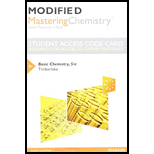
Concept explainers
(a)
Interpretation:
In the following reactions, identify the reactant that is oxidized and the reactant that is reduced:
Concept Introduction:
The rules for assigning oxidation number to elements are:
- For an element in its free state it is assigned an oxidation number of zero.
- Monatomic ions have oxidation number that is equal to charge of the monatomic ion.
- Alkali metals have +1 oxidation number, alkaline earth metals have +2 oxidation number and halogens are assigned -1 oxidation number.
- In most compounds H is assigned a +1 oxidation number and O is assigned a -2 oxidation number.
- For a neutral compound the summation of oxidation numbers of all elements in the compound is zero.
If the oxidation number of an element increases then it undergoes oxidation and if the oxidation number of the element decreases then it undergoes reduction.
(b)
Interpretation:
In the following reactions, identify the reactant that is oxidized and the reactant that is reduced:
Concept Introduction:
The rules for assigning oxidation number to elements are:
- For an element in its free state it is assigned an oxidation number of zero.
- Monatomic ions have oxidation number that is equal to charge of the monatomic ion.
- Alkali metals have +1 oxidation number, alkaline earth metals have +2 oxidation number and halogens are assigned -1 oxidation number.
- In most compounds H is assigned a +1 oxidation number and O is assigned a -2 oxidation number.
- For a neutral compound the summation of oxidation numbers of all elements in the compound is zero.
If the oxidation number of an element increases then it undergoes oxidation and if the oxidation number of the element decreases then it undergoes reduction.
(c)
Interpretation:
In the following reactions, identify the reactant that is oxidized and the reactant that is reduced:
Concept Introduction:
The rules for assigning oxidation number to elements are:
- For an element in its free state it is assigned an oxidation number of zero.
- Monatomic ions have oxidation number that is equal to charge of the monatomic ion.
- Alkali metals have +1 oxidation number, alkaline earth metals have +2 oxidation number and halogens are assigned -1 oxidation number.
- In most compounds H is assigned a +1 oxidation number and O is assigned a -2 oxidation number.
- For a neutral compound the summation of oxidation numbers of all elements in the compound is zero.
If the oxidation number of an element increases then it undergoes oxidation and if the oxidation number of the element decreases then it undergoes reduction.
(d)
Interpretation:
In the following reactions, identify the reactant that is oxidized and the reactant that is reduced:
Concept Introduction:
The rules for assigning oxidation number to elements are:
- For an element in its free state it is assigned an oxidation number of zero.
- Monatomic ions have oxidation number that is equal to charge of the monatomic ion.
- Alkali metals have +1 oxidation number, alkaline earth metals have +2 oxidation number and halogens are assigned -1 oxidation number.
- In most compounds H is assigned a +1 oxidation number and O is assigned a -2 oxidation number.
- For a neutral compound the summation of oxidation numbers of all elements in the compound is zero.
If the oxidation number of an element increases then it undergoes oxidation and if the oxidation number of the element decreases then it undergoes reduction.
Want to see the full answer?
Check out a sample textbook solution
Chapter 8 Solutions
Modified Masteringchemistry With Pearson Etext -- Standalone Access Card -- For Basic Chemistry Format: Access Card Package
 ChemistryChemistryISBN:9781305957404Author:Steven S. Zumdahl, Susan A. Zumdahl, Donald J. DeCostePublisher:Cengage Learning
ChemistryChemistryISBN:9781305957404Author:Steven S. Zumdahl, Susan A. Zumdahl, Donald J. DeCostePublisher:Cengage Learning ChemistryChemistryISBN:9781259911156Author:Raymond Chang Dr., Jason Overby ProfessorPublisher:McGraw-Hill Education
ChemistryChemistryISBN:9781259911156Author:Raymond Chang Dr., Jason Overby ProfessorPublisher:McGraw-Hill Education Principles of Instrumental AnalysisChemistryISBN:9781305577213Author:Douglas A. Skoog, F. James Holler, Stanley R. CrouchPublisher:Cengage Learning
Principles of Instrumental AnalysisChemistryISBN:9781305577213Author:Douglas A. Skoog, F. James Holler, Stanley R. CrouchPublisher:Cengage Learning Organic ChemistryChemistryISBN:9780078021558Author:Janice Gorzynski Smith Dr.Publisher:McGraw-Hill Education
Organic ChemistryChemistryISBN:9780078021558Author:Janice Gorzynski Smith Dr.Publisher:McGraw-Hill Education Chemistry: Principles and ReactionsChemistryISBN:9781305079373Author:William L. Masterton, Cecile N. HurleyPublisher:Cengage Learning
Chemistry: Principles and ReactionsChemistryISBN:9781305079373Author:William L. Masterton, Cecile N. HurleyPublisher:Cengage Learning Elementary Principles of Chemical Processes, Bind...ChemistryISBN:9781118431221Author:Richard M. Felder, Ronald W. Rousseau, Lisa G. BullardPublisher:WILEY
Elementary Principles of Chemical Processes, Bind...ChemistryISBN:9781118431221Author:Richard M. Felder, Ronald W. Rousseau, Lisa G. BullardPublisher:WILEY





